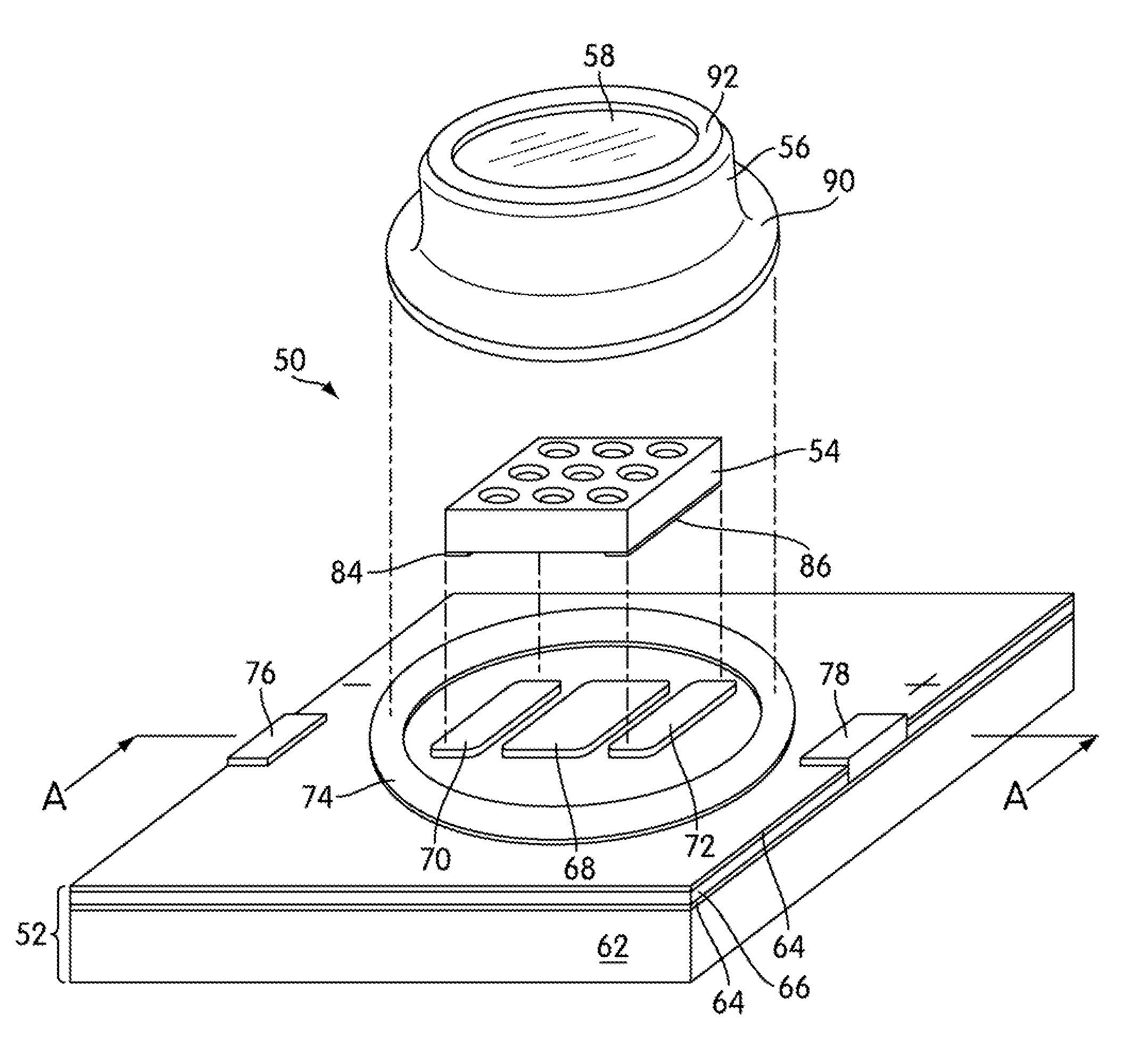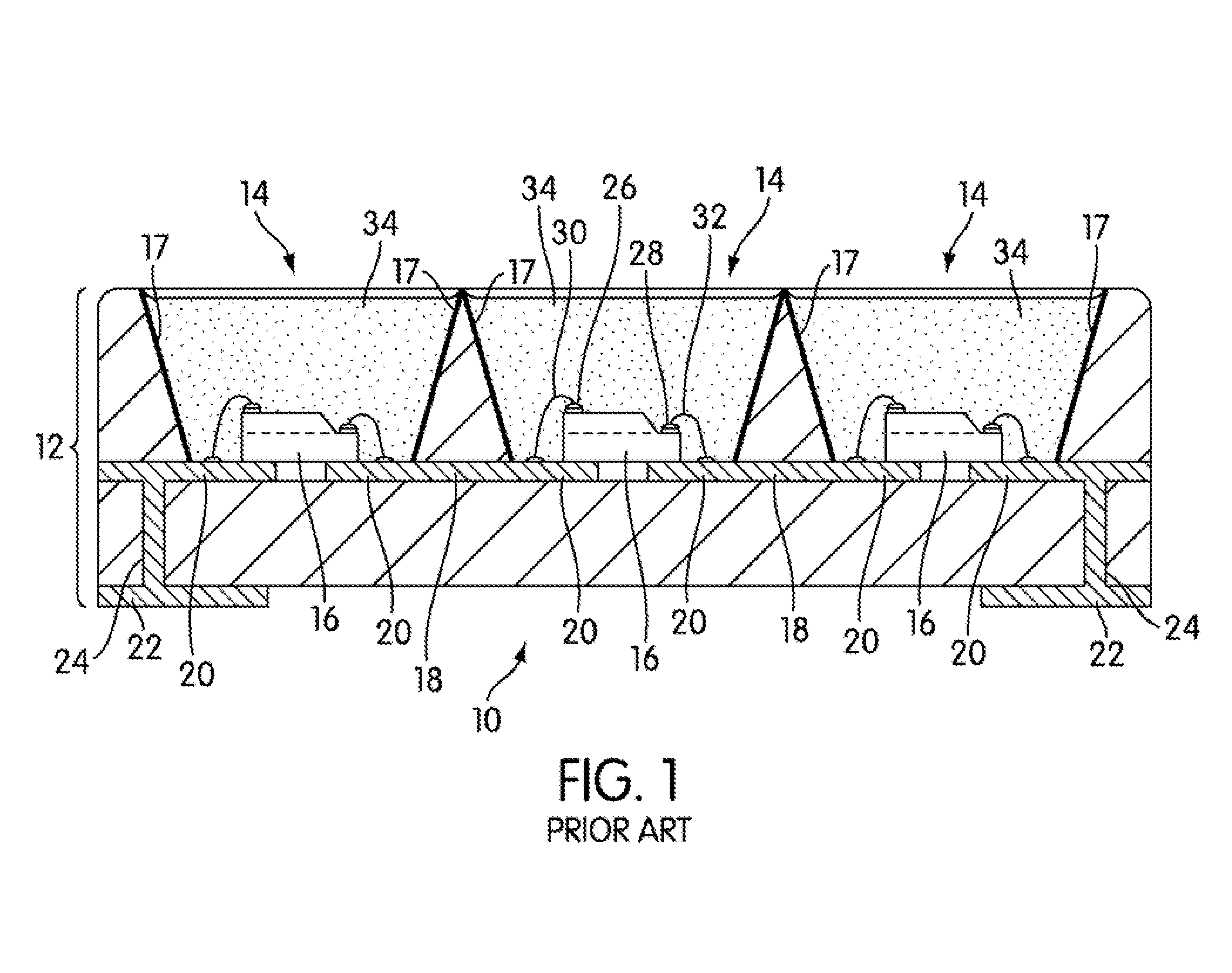Light emitting device with phosphor wavelength conversion
a technology of light emitting devices and wavelength conversion, which is applied in the direction of semiconductor devices for light sources, discharge tubes luminescnet screens, lighting and heating apparatus, etc., can solve the problems of significant change in the correlated color temperature (cct) and/or intensity of light emitted by the device, and achieve the effect of reducing water absorption, reducing phosphor degradation, and eliminating phosphor degradation
- Summary
- Abstract
- Description
- Claims
- Application Information
AI Technical Summary
Benefits of technology
Problems solved by technology
Method used
Image
Examples
first embodiment
[0032]A light emitting device 50 in accordance with the invention will now be described with reference to FIGS. 2 and 3 of the accompanying drawings. The device 50 is configured to generate white light with a specific correlated color temperature (CCT) for example 2700K and an emission intensity of ≧250 lumens (i.e. ≧3 W input power) preferably ≧500-600 lumens (i.e. ≧6 W input power). The device is intended for general lighting applications such as a replacement for an incandescent, fluorescent or cold cathode fluorescent light source. It will be appreciated that the device of the present invention is not limited to such applications, emission colors or emission intensities.
[0033]Referring to FIGS. 2 and 3 the device 50 comprises a thermally conducting substrate 52 such as for example a metal core printed circuit board (MCPCB); a packaged LED array 54; a hollow metal housing (can) 56; a light transmissive (transparent) window 58 and a layer of one or more phosphor materials 60 on th...
second embodiment
[0052]Referring to FIG. 4 there is shown a schematic sectional representation of a light emitting device 50 in accordance with the invention in which a single light transmissive cover 102 is used in place of the housing / window 56 / 58 assembly. The cover 102 preferably comprises a glass such as a silica glass or quartz glass or a light transmissive inorganic material such as transparent alumina (Al2O3). The phosphor material(s) 60 is / are provided as a uniform layer over the inner surface of the cover 102. A metallization layer 104, comprising for example copper (Cu), nickel (Ni) or chromium (Cr), can be provided on at least the base of the cover 102 to enable the cover 102 to be soldered 94 or otherwise attached to the mounting pad 74. An advantage of using a single glass cover member 102 is that only a single seal 94 with the substrate 52 is required.
third embodiment
[0053]FIG. 5 is a schematic sectional representation of a light emitting device 50 in accordance with the invention. In this embodiment the glass cover member 102 comprises a substantially hemispherical (dome shaped) shell. To maximize light emission from the device 50 a metallization 106 can be provided on the interior surface of the cover member 102 that extends from the base of the cover. As shown in FIG. 5 individual LED chips 83 are mounted in direct thermal communication with the MCPCB 52 rather than a packaged array of LEDs—that is a chip-on-board (COB) arrangement.
[0054]FIG. 6 shows a schematic sectional representation of a light emitting device 50 in accordance with a forth embodiment of the invention in which the housing 56 is configured in the form of a parabolic reflector and is generally dish-shaped in form. As in other embodiments, the housing 56 is attached to the MCPCB (substrate) 52 to form a water tight, preferably air / gas tight, seal. In the embodiment illustrated...
PUM
| Property | Measurement | Unit |
|---|---|---|
| Luminous flux | aaaaa | aaaaa |
| Luminous flux | aaaaa | aaaaa |
| Luminous flux | aaaaa | aaaaa |
Abstract
Description
Claims
Application Information
 Login to View More
Login to View More - R&D
- Intellectual Property
- Life Sciences
- Materials
- Tech Scout
- Unparalleled Data Quality
- Higher Quality Content
- 60% Fewer Hallucinations
Browse by: Latest US Patents, China's latest patents, Technical Efficacy Thesaurus, Application Domain, Technology Topic, Popular Technical Reports.
© 2025 PatSnap. All rights reserved.Legal|Privacy policy|Modern Slavery Act Transparency Statement|Sitemap|About US| Contact US: help@patsnap.com



